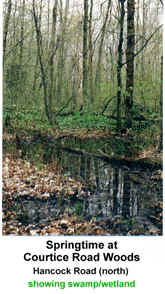|
Last updated
24 August 2012
| |
Wetland can be defined as an area of land which is
covered by water for part or all of the year.

There are four types of wetlands:
|
SWAMP
Characterized by flooded trees
May dry out each summer
Support woody plant life
Characterized by trees such as maple, ash, cedar
(Courtice North Wetland Complex)
MARSH
Most productive for wildlife
Have mixture of diverse emergent plants and open water
Contains cattails, bulrush, sedges, arrowhead, duckweed, wild iris,
water lily (Oshawa Second Marsh)
BOG
Found mostly in the North
Soil mainly peat(decomposed plants) making this type unique
Tends to have poor drainage (no outflow)
Low oxygen: acidic
Very old
Vegetation include sphagnum moss, cotton grasses, pitcher plants, sedges and black spruce
(Solina Bog)
FEN
Similar to a bog with better drainage
Lower acidity, more plant life
Most common in Northern areas
Plants includelow shrubs, sedges, grasses, pitcher plant, sundew
Low oxygen: alkaline
WHY ARE WETLANDS IMPORTANT?
|
|
